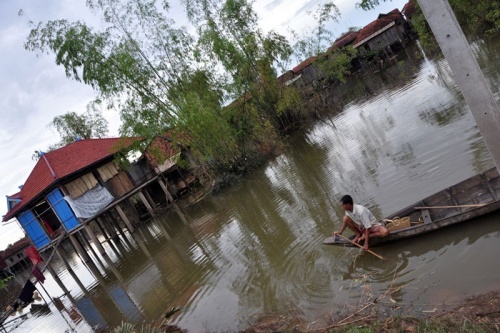
Massive flooding across South-East Asia is inflicting greatest damage upon children - with over 200 already having lost their lives, many due to drowning, and hundreds of thousands at risk of missing school because of damage to infrastructure according to UN agencies.
The floods – a result of heavy seasonal rains and frequent cyclones – have affected eight million people across Cambodia, Laos, the Philippines, Thailand and Viet Nam. To date, 745 people are reported dead as a result of the flooding, including over 200 children. In Cambodia alone, 80 children have died, mostly from drowning.
Clean Water, Food & Education:
According to the UN Children’s Fund (UNICEF), the most urgent needs for children are clean water, hygiene supplies to prevent the spread of disease, food supplies and safe places in evacuation centers for children to play. The agency is working with the affected governments and partners to provide immediate assistance to those who need it most. The World Food Programme (WFP) said it is launching an emergency operation to address the immediate food needs of some 12,000 households, or 60,000 people, in Cambodia.
The main aim of the $500,000 emergency operation was to save lives and protect livelihoods by averting damaging coping mechanisms which were already being adopted by affected households. These included borrowing rice at very high interest rates, selling assets, pulling children out of school, and reducing food intake.
In many of the affected countries, the school year was scheduled to begin this month, the agency noted. However, massive damage to school infrastructure and supplies will mean hundreds of thousands of children may miss weeks or months of school. Over 1,300 schools in Cambodia, or 17 per cent of the total, are affected by the floods. Roughly 75 per cent of these schools were not able to open for the new academic year on 1 October, affecting 455,000 children. In Thailand, over 3,000 educational institutions have been affected.
Damage as Consequence of Poor Location/Design of Homes, Schools & Production Facilities:
The UN International Strategy for Disaster Reduction (UNISDR) also voiced their concern at the many children who have died as a result of the floods, as well as the thousands of workers unemployed because of poorly located manufacturing plants. It is urging the affected governments to open discussions with the private sector on what adjustments need to be made in their land use to locate their factories in disaster-proof areas to better protect their workers and prevent them from building their homes in unsafe areas.
Across the region, the well-being of millions would be drastically affected by the loss of livelihoods, as manufacturing plants were forced to shut and agriculture struggled to recover, ISDR noted.
While precise figures are not yet available, the floods are estimated to have damaged over three million hectares of cropland across the region. In addition, loss of livestock and poultry is reported and significant numbers are considered to be at risk, according to a report released by the Food and Agriculture Organization’s (FAO) Global Information and Early Warning System.
By Ambassador Muhamed Sacirbey
Facebook Become a Fan at “Diplomatically Incorrect”
Twitter – Follow at DiplomaticallyX
Humanitarian Channel -
diplomaticallyincorrect.org/c/humanitarian

